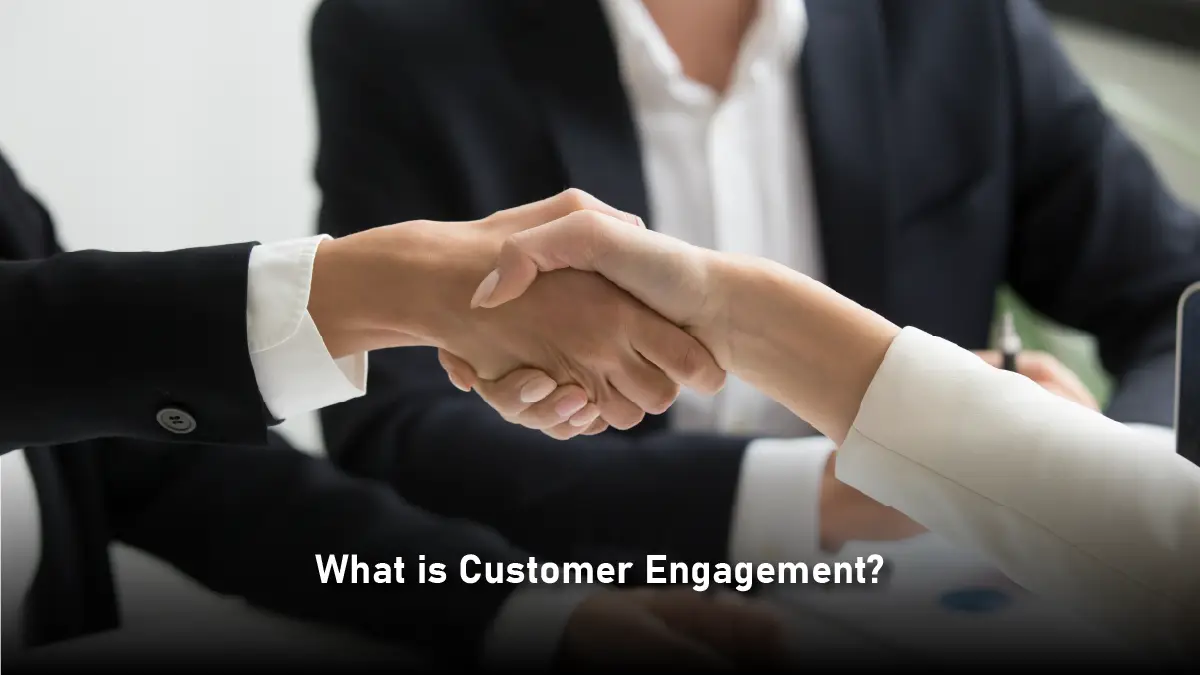Imagine you liked a product or service from a company and asked them a question about it. However, they did not respond at all. Would you still be considering that brand?
A big no, right?
This is exactly why a customer engagement platform is important. Today, AI-powered personalization is setting the standard. Deloitte’s Digital Consumer Trends 2025 report found that 58% of consumers in the UAE and KSA already use generative AI tools like ChatGPT or Google Gemini which proofs that personalized, intelligent interactions are now mainstream, not optional.
This article explains why your business must consider customer engagement to form better relationships with your audience.
What is Customer Engagement?
 Establishing a relationship with customers that extends beyond a simple transaction is known as customer engagement. It’s a deliberate, methodical strategy used by a business to add value to every contact with customers, boosting loyalty.
Establishing a relationship with customers that extends beyond a simple transaction is known as customer engagement. It’s a deliberate, methodical strategy used by a business to add value to every contact with customers, boosting loyalty.
Although there is considerable overlap, customer engagement, customer interaction, and customer experience are different concepts. Later on, we’ll go into much more detail on these ideas, but for now, you should know that customer experience is the impression that customers get of your business from everything they see, hear, or read.
The World Economic Forum highlights how 74% of organizations adopting AI see ROI in under a year, showing that customer engagement done right doesn’t just boost loyalty, it drives measurable business outcomes.
Why is Customer Engagement Important for Business?
 Businesses and other organizations significantly benefit from implementing successful customer engagement strategies. For instance, creating personalized customer experiences can foster long-term loyalty and positive brand perception within the market.
Businesses and other organizations significantly benefit from implementing successful customer engagement strategies. For instance, creating personalized customer experiences can foster long-term loyalty and positive brand perception within the market.
- Customer Retention: Acquiring new customers can sometimes come at a higher cost compared to retaining them. The cost of customer acquisition can greatly exceed that of customer retention. By implementing effective strategies for engagement, businesses can prolong the customer journey, moving beyond the initial interaction or purchase and significantly reducing churn rates. Engaged customers often transition into valuable repeat buyers.
- Brand awareness: Brand awareness refers to the level of familiarity and recognition that consumers have with a particular brand. It represents the extent to which a brand is known by its target audience and is an essential component of a successful marketing strategy.
- Loyal customers: Cultivating emotional connections with customers is a key factor in boosting loyalty towards brands. Yet there’s a growing trust gap. Deloitte research shows that while 90% of customers interact with Customer Success teams, only about a quarter fully trust their providers. Closing this gap with authentic, proactive engagement is what turns satisfied buyers into true advocates.
- Lasting Customer Experience: Creating an outstanding customer experience extends beyond a single transaction; it boosts satisfaction and drives sales. A robust customer journey optimizes every interaction point between the individual and the organization, including user-friendly websites, compelling content sharing, and prompt customer service. Marketing focused on the customer experience is instrumental in managing these interactions.
- Anticipating customer needs: This plays a pivotal role in cultivating robust client engagement. By actively embracing efficient customer service strategies and consistently monitoring customer feedback, companies gain profound insights into customer behavior, needs, and preferences. These insights catalyze innovation, leading to the development of new products and services that are finely tuned to meet and exceed customer expectations.
Beyond softer benefits like loyalty, the World Economic Forum reports that 86% of organizations using AI in engagement saw revenues grow by 6% or more, with nearly three-quarters achieving ROI inside a year. That means customer engagement isn’t just about relationships, it’s a measurable growth lever.
Also Read: Personalized Customer Engagement: 9 Ways for Improved Conversion Rate
What are the 4 P’s of Customer Engagement?
The concept of the 4 Ps of customer engagement serves as a foundational framework that empowers businesses to grasp and execute effective strategies for engaging with their customer base.
Product: When a business sets out to thrive, the very first aspect (P) in the equation pertains to the product or service it extends to its customers. It’s all about tuning in to the needs and tastes of the customer base and devising solutions that cater precisely to those requirements. A top-notch, meticulously crafted product stands as the cornerstone for attracting and retaining customers and nurturing a profoundly positive customer journey. Increasingly, that also means embedding intelligence. AI-driven product recommendations and personalization are now baseline expectations in industries from retail to media.
Price Tag: The second component of the marketing mix revolves around the pricing strategy applied to a product or service. Setting prices plays a critical role in engaging customers, as it influences their perceived value and purchase behavior. Businesses must navigate finding the proper equilibrium between competitively pricing their products while also acknowledging customer views on value and affordability. Dynamic pricing tools powered by machine learning are helping brands find that balance in real time.
Place: The third P delves into the realm of distribution channels and physical touchpoints that serve as gateways for customers to engage with products or services. It revolves around identifying the most seamless and accessible channels for customers to interact with the brand, whether through traditional brick-and-mortar establishments, modern digital platforms, or a fusion of both avenues.
Promotion: This is part of the marketing mix’s fourth P hinges on effectively communicating and interacting with customers. It encompasses a range of marketing strategies and advertising initiatives aimed at building awareness, generating interest, and stimulating customer engagement. These promotional activities are executed through various channels, including social media, email marketing, content marketing, and traditional advertising methods. Today, AI is rewriting the playbook: The World Economic Forum notes how personalization engines on streaming platforms, retail apps, and social media drive engagement by tailoring recommendations to each user. In other words, promotion has evolved into personalized, multi-channel conversations rather than one-size-fits-all campaigns.
When businesses strategically optimize these four key elements, they pave the way for developing a well-rounded engagement strategy that resonates with the preferences, needs, and behaviors of their customers.
Top 5 Established Customer Engagement Platforms
Salesforce Customer 360: Salesforce Customer 360 is a comprehensive customer engagement platform that offers a range of tools and solutions for managing customer relationships, sales, marketing, and service. It provides a unified view of customer data, enabling businesses to personalize interactions and deliver seamless experiences across multiple channels. Today, Salesforce is embedding Einstein AI across its suite, powering predictive insights, automated recommendations, and smarter workflows.
HubSpot: HubSpot is a widely used customer engagement platform that offers a suite of tools for marketing, sales, and customer service. It provides features such as email marketing, social media management, live chat, and customer relationship management (CRM) capabilities, all aimed at enhancing customer engagement and nurturing relationships. HubSpot has added AI-powered content assistants, advanced automation, and predictive lead scoring to streamline engagement strategies.
Zendesk: Zendesk is a customer service and engagement platform that helps businesses manage customer support interactions across various channels, including email, chat, phone, and social media. It offers features like ticketing systems, knowledge bases, and customer self-service options, enabling businesses to provide efficient and personalized support experiences. Zendesk now integrates AI bots and intent detection, helping teams resolve queries faster while keeping human interactions meaningful.
Adobe Experience Cloud: Adobe Experience Cloud is a comprehensive platform that combines marketing, analytics, and advertising tools to deliver personalized and engaging customer experiences. It offers capabilities for data management, content creation, campaign management, and customer journey mapping, empowering businesses to create targeted and impactful customer engagements. With Adobe Sensei GenAI, the platform now enables generative content creation and real-time personalization at scale.
Intercom: Intercom is a customer messaging platform that enables businesses to engage with customers through personalized, real-time conversations. It offers features like live chat, chatbots, email marketing, and customer segmentation, helping businesses deliver proactive and relevant communications to drive customer engagement and satisfaction. Intercom’s latest update includes Fin AI Copilot, designed to automate support conversations while still keeping the human tone intact.
5 Emerging Customer Engagement Platforms in 2025
While established platforms like Salesforce, HubSpot, and Zendesk continue to dominate, a new generation of customer engagement tools is gaining attention. These solutions are designed for speed, AI-first automation, and hyper-personalization, making them ideal for businesses looking to modernize engagement in 2025. Here’s a closer look at five platforms making waves today.
Drift: Drift specializes in conversational marketing and sales. Its AI-powered chatbots engage visitors in real time, qualify leads, schedule meetings, and deliver personalized content. Drift is particularly strong for B2B businesses looking to turn conversations into actionable pipeline opportunities, enabling human-like interactions at scale.
MoEngage: MoEngage focuses on data-driven, omni channel engagement. It helps brands orchestrate push notifications, email, SMS, and in-app messages with AI-powered personalization. Popular in mobile-first and emerging markets, MoEngage enables businesses to create targeted customer journeys quickly, keeping engagement relevant and automated.
Iterable: Iterable is a growth marketing platform designed for cross-channel messaging. It empowers brands to send personalized campaigns across email, SMS, push, and web channels. With AI-driven automation and journey orchestration, Iterable allows marketers to optimize engagement workflows and deliver timely, contextual messages without heavy manual effort.
Twilio Segment: Twilio Segment acts as a customer data and engagement hub. It centralizes data from multiple sources and enables seamless integration with marketing, analytics, and messaging tools. By providing a unified view of the customer, Segment allows businesses to personalize experiences and orchestrate campaigns across channels effectively.
ActiveCampaign: ActiveCampaign combines CRM, email marketing, and marketing automation into a single platform. Its AI-powered features help businesses segment audiences, automate personalized campaigns, and manage customer journeys. Particularly popular among small and mid-sized businesses, ActiveCampaign enables enterprise-style engagement without the complexity of larger platforms.
These emerging platforms may not yet have the market dominance of Salesforce or HubSpot, but they are lean, AI-first, and fast to deploy, giving businesses the tools to stay agile and deliver modern, personalized customer engagement in 2025.
Decoding Customer Engagement Platform Vs CRM
Customer engagement platforms (CEPs) and customer relationship management (CRM) systems serve different purposes in managing customer interactions, but they complement each other. Understanding the distinction is key for businesses planning their engagement strategy.
CRM systems primarily focus on organizing and managing customer data. They provide a centralized database to store customer information, track interactions, and optimize marketing, sales, and support processes. Traditional CRMs are excellent for tracking customer history, managing pipelines, and maintaining structured data, but they often require additional tools to execute real-time, personalized engagement across channels.
CEPs go beyond data management to enhance every customer interaction across multiple channels and touchpoints. They leverage insights from CRM and other sources to deliver personalized, timely, and proactive communications. Modern CEPs integrate AI and automation to:
- Predict customer behavior: Using machine learning to anticipate needs and preferences.
- Personalize interactions: Automating content recommendations, targeted messaging, and journey orchestration.
- Optimize engagement workflows: Streamlining campaigns and customer service with AI bots and automation.
For example, while a CRM might record that a customer purchased a product last month, a CEP can trigger a personalized follow-up email or in-app recommendation, nudging the customer toward a repeat purchase or subscription renewal.
Final Takeaway
Think of CRMs as the backbone for storing and managing customer data, while CEPs are the engine that powers meaningful, intelligent engagement. Together, they allow businesses to deliver seamless, AI-enhanced experiences, turning insights into actions that strengthen customer loyalty and drive growth.


Comments are closed.